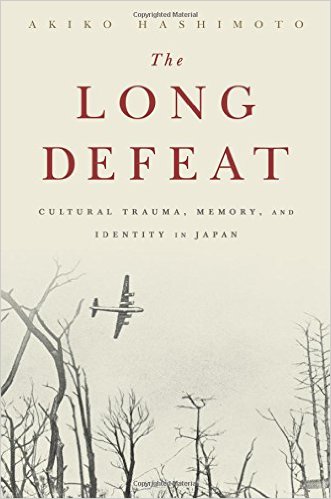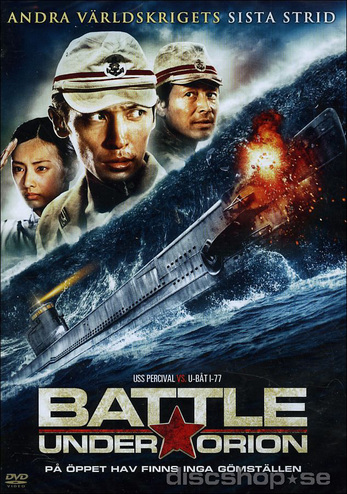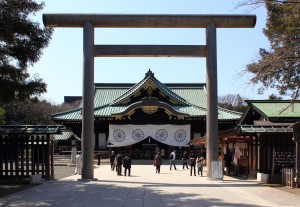Books: The Long Defeat
January 1, 2016 · 0 comments
by Lee Brimmicombe-Wood.
 When it comes to WW2 war guilt, Germany sets the gold standard. As a nation it has accepted responsibility for the Holocaust, acted to suppress the symbols of the Nazi regime, and has made great efforts to reconcile with its neighbours.
When it comes to WW2 war guilt, Germany sets the gold standard. As a nation it has accepted responsibility for the Holocaust, acted to suppress the symbols of the Nazi regime, and has made great efforts to reconcile with its neighbours.
Japan seems to stand in contrast to this. Aside from a brief blip when the socialists came to power in the mid-1990s, apologies have at best been highly qualified. In recent years right-wing prime ministers, such as Junichiro Koizumi and Shinzo Abe have walked such statements back, and a new breed of neo-nationalist fire breathers such as Toru Hashimoto have been stoking the fires. Relations with neighbours such as China and Korea are tense, and with the annual brouhaha over Prime Ministerial visits to the Yasukuni Shrine, where Category A war criminals are enshrined, and Shinzo Abe’s efforts to redefine Article 9 of the Constitution, Japan looks increasingly like a nation in denial of its past.
 Akiko Hashimoto’s new study, The Long Defeat: Cultural Trauma, Memory and Identity in Japan, suggests things are far more complicated than that. She sees not a nation in denial but one in which there are many competing voices. In particular she looks at the way WW2 has been memorialised since the 1990s. These were the years when many nations realised that their veterans of the war were beginning to die off, and launched projects to create archives of testimony, either directly from veterans, or from their children. For example, in Britain we had the BBC’s ‘People’s War’ project.
Akiko Hashimoto’s new study, The Long Defeat: Cultural Trauma, Memory and Identity in Japan, suggests things are far more complicated than that. She sees not a nation in denial but one in which there are many competing voices. In particular she looks at the way WW2 has been memorialised since the 1990s. These were the years when many nations realised that their veterans of the war were beginning to die off, and launched projects to create archives of testimony, either directly from veterans, or from their children. For example, in Britain we had the BBC’s ‘People’s War’ project.
In Japan, many of these archive projects were started by newspapers, which would print recollections and eye-witness testimonies. These would go on to be collected in multi-volume books. Of these recollections there were a few heroic narratives. However, most were victim stories and a good proportion were perpetrator narratives. The latter were sometimes from veterans themselves, seeking to confess old crimes, or from children, painting portraits of abusive old warriors. Overwhelmingly, the victim and perpetrator narratives dominate, so that the abiding memory of the war is of a catastrophe, largely brought upon the nation by its own leadership. This memory is one of the sources of opposition to attempts to change Article 9. ‘Never Again’ is rooted deep in the popular consciousness and is reflected in the way in which through the noughties three major national newspapers ran annual editorials defining Japan’s past as a perpetrator nation.
In addition to the archive efforts, newspapers and television have often engaged in serious investigative journalism. In the case of the papers, this resulted in not one but two papers conducting their own war crimes trials. For the Yomiuri Shimbun, a generally conservative paper, this resulted in an extraordinary reversal of the paper’s policy on the Yasukuni Shrine. From 2005 it would no longer defend visits to the shrine or the records of the Class A war criminals enshrined there.
The documentary TV series NHK Special has also run a number of investigative reports on the war. The 2009 piece Japanese Navy’s 400 hours of testimonies ran tapes of ex-officers who met covertly in the decades between the 1970s and 1990s to talk about the Navy’s blunders and crimes. These revealed candid confessions of efforts to shield their leaders at the Tokyo Trials, crimes committed in the Philippines and even frank discussions of the Showa Emperor’s war responsibility. The 2011 four-part series Why did the Japanese go to war? looked at the opportunism, negligence and collusion of military, government, power elite and media that failed to stop the slide to war. Meanwhile the Army’s dabbling in the opium trade to finance the war resulted in 2008’s report The Japanese Army and Opium. A 2009 report on the historical circumstances that led to war was particularly hard on the Japanese media, which helped manufacture the will to war and marched in lockstep with state censorship.
Naturally there has been pushback against such programs from the right wing, which accuse the perpetrator narratives of being ‘politically correct’. However, the left has also attacked them as often muddying the perpetrator narratives, and often leaving a lot of ambiguity.
 Meanwhile new narratives are being developed. Many of these are in comics, TV shows and movies that emphasise the heroic side of the war. The sentiments of these films are muddled, sometimes seeming pro-war while rejecting the more brutal historical practices seen in the war. In the 2009 film Battle Under Orion the kindly sub captain refuses to send his men out as human torpedoes. In 2009’s Eternal Zero the ace pilot fights not for the Emperor but for love of his family. These films are completely anachronistic—men who’d been through an ‘arranged’ omiai marriage are unlikely to have had the modern romantic sentiment towards their families that the films ascribe to them. However, a generation of Japanese are now growing up with stories about good men in a bad war, doing their duty.
Meanwhile new narratives are being developed. Many of these are in comics, TV shows and movies that emphasise the heroic side of the war. The sentiments of these films are muddled, sometimes seeming pro-war while rejecting the more brutal historical practices seen in the war. In the 2009 film Battle Under Orion the kindly sub captain refuses to send his men out as human torpedoes. In 2009’s Eternal Zero the ace pilot fights not for the Emperor but for love of his family. These films are completely anachronistic—men who’d been through an ‘arranged’ omiai marriage are unlikely to have had the modern romantic sentiment towards their families that the films ascribe to them. However, a generation of Japanese are now growing up with stories about good men in a bad war, doing their duty.
This leads to some confusion for modern youth. Many don’t understand the attitudes of their forebears. Why did they willingly go to die for their emperor? Some are just not sure what to believe, or even what ‘taking responsibility’ means. It’s interesting that polls show the Japanese to have the lowest levels of patriotism amongst the developed nations. There’s not yet a strong narrative to define how to be proud of Japan, though the neo-nationalists are working hard to fill that vacuum.
One of the ways they are doing that is through school teaching, which Hashimoto examines in a superb analysis of Japanese high school history textbooks. Again, things tend to be complex. There are many texts for schools to choose from and there is a range of views on the war, some of which push the perpetrator narratives stronger than others. Overall, the history seems to be quite good, but it’s clear that the more conservative texts parse the wording very carefully so as to take out the sting. In general, the division is between those texts that paint the war as a war of choice and those that treat it as a war of necessity. The difference is subtle but the latter is a far more conservative view.
However, textbooks are not the only form of pedagogy described. All Japanese kids get exposed at some point to one or more of the nation’s many ‘peace museums’, which often push an anti-war message. Similarly, many of the manga used to introduce schoolkids to history, including Shigeru Mizuki’s history of the Showa years, are overwhelmingly anti-war (Hashimoto’s description of the Doraemon war history is very entertaining). However it’s notable that these lean heavily on victim narratives that carry their own dangers. A nation of victims may be insufficiently introspective.
Hashimoto finishes by looking at the ways in which defeated nations can recover. Japan is not like Germany in that it has never perceived itself to be at the top table of great powers, never an equal. Germany was such a power, which made its reintegration into Europe after 1945 far easier.
As Japan struggles to establish its own position as a modern power, which path does it take? The nationalist emphasis is on the recovery of prestige and respect. In practice this means ending military disempowerment by changing Article 9 and legitimising the JSDF as a military force. Furthermore they aim to reduce dependence on the US for security and push Japanese prestige through events such as the 2020 Olympics. For the neo-nationalists, stimulating patriotism and national pride would be undermined by apologies that diminish Japan.
 The pacifist path is a counterweight to neo-nationalism. The Article 9 Association has become a powerful pressure group agitating against the Abe government’s efforts to alter the Constitution. Groups like the A9A and Save Constitutional Democracy try and create national pride through pledges to disarmament and non-interventionism. A very different mode of civic identity to the nationalists.
The pacifist path is a counterweight to neo-nationalism. The Article 9 Association has become a powerful pressure group agitating against the Abe government’s efforts to alter the Constitution. Groups like the A9A and Save Constitutional Democracy try and create national pride through pledges to disarmament and non-interventionism. A very different mode of civic identity to the nationalists.
Then there is the reconciliationist approach that tries to build relations with Japan’s neighbours. One effort associated with the reconciliationists is the tri-national history textbook called History That Opens the Future, published in 2005 in Japanese, Chinese and Korean. This emphasises the perpetrator narrative in its section on Japan but aims to achieve a dialogue between the nations. This is a hard row to hoe, given how large numbers of Koreans and Chinese still view Japan as a militaristic power. This view has only got worse in recent years and the lack of an apology only reinforces attitudes.
The notion of repentance is a very Western attitude, rooted in Judeo-Christian tradition. It does not carry the same resonance in the Far East. Japan still perceives itself to be an ‘outsider’ nation in the international system. An apology requires a self-redefinition—an admission of barbarism—that is inconsistent with the nation’s long-standing goal of attaining equality with the West. Conforming to the ‘German standard’ accrues symbolic capital with the rest of the world and yet also confirms the Western stereotype of the ‘yellow menace’. Is it any wonder then that the Japanese government, and particularly a conservative one, might not see much of a percentage in repentance?
The Long Defeat: Cultural Trauma, Memory and Identity in Japan by Akiko Hashimoto is out now from Oxford University Press.
Leave a Reply